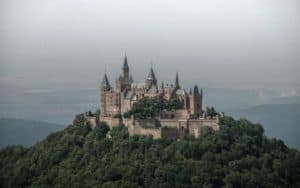The Impact of the Celtic Tiger on Irish Cultural Identity: Evolution and Change

Updated On: April 21, 2024 by Eman Sameh
The period known as the Celtic Tiger represents one of the most dynamic times in Ireland’s recent history, bringing with it profound economic growth and significant changes to the nation’s cultural identity. From the mid-1990s to the late 2000s, Ireland experienced an unparalleled economic boom, which earned it the nickname ‘Celtic Tiger,’ likening its sudden growth to the rapidly developing economies of East Asia’s ‘tigers’. This transformative era had lasting impacts on public life, the arts, and the perception of what it means to be Irish, both domestically and on the international stage.

As Ireland’s economy flourished, the very fabric of Irish society was altered. The influx of foreign investment, the rise in employment, and the subsequent increase in immigration brought about a multicultural dimension that was practically unprecedented in Irish history. This societal shift fed into various aspects of life, leading to a reassessment of traditional cultural practices, an evolving literary scene, and a newfound confidence on the global political stage. The transformation of Ireland during the Celtic Tiger years extended beyond economic figures; it spoke to the heart of Irish national identity, challenging and reshaping it as the country stepped into the 21st century.
Historical Context of the Celtic Tiger

Before delving into the specifics, it’s important to understand that the Celtic Tiger represents a period of swift economic growth in Ireland that coincided with broader changes in cultural identity. This era was characterised by a surge in investment and the transformation of the Irish economy.
Origins of Economic Growth
The Celtic Tiger period, spanning from around 1995 to 2007, marked a significant transformation in Ireland’s economic fortune. This era was underpinned by a series of policy reforms that focused on attracting foreign direct investment (FDI), introducing low corporate tax rates, and investing in education and infrastructure. By strategically positioning ourselves within the global economy, Ireland cultivated a favourable environment for multinational corporations, particularly those in the technology and pharmaceutical sectors. These reforms, combined with a young, well-educated workforce, propelled the economy forward and resulted in unprecedented levels of economic growth.
International Factors
Ireland’s ascension to the European Union (EU) played a pivotal role in the Celtic Tiger phenomenon. Our inclusion in the EU not only provided access to European markets but also resulted in substantial EU structural funds, which were integral to modernising our infrastructure. As globalisation accelerated, international trends towards liberalising trade and capital flows further amplified Ireland’s attractiveness as an investment destination. This laid the groundwork for significant increases in FDI, making Ireland a standout performer within the EU in terms of economic growth rates. Our economy experienced levels of expansion that were unheard of in previous decades, changing the landscape of Irish society and its cultural identity.
Cultural Identity and Nationalism
In evaluating the Celtic Tiger’s influence, it is imperative to consider its multifaceted impact on Irish cultural identity and nationalism.
Irish Society and Identity
The era of the Celtic Tiger brought profound transformations within Irish society, fundamentally altering perceptions of Irish identity. Economic prosperity facilitated the emergence of a more cosmopolitan society, which simultaneously fostered a sense of national confidence. However, this shift also introduced challenges, as traditional cultural practices and values encountered the forces of modernity and global influences. The immigration wave during the Celtic Tiger period propelled a re-examination of what it meant to be Irish as the definition of Irishness expanded beyond its historical narratives.
Effects on Irish National Identity
Nationalism in Ireland, traditionally steeped in a rich tapestry of historical struggles and literary revivals, found itself at a crossroads during the post-Celtic Tiger period. The newfound wealth and global connectivity prompted introspection into Ireland’s place in the world, influencing the path of Irish nationalism. While economic growth had bolstered national pride, the subsequent economic downturn led many to question the sustainability of Ireland’s identity in the absence of such prosperity. The enduring challenge has been to balance the preservation of Irish culture with integration into a globalised community, ensuring that identity evolves while retaining its distinctive essence. A reflection of contemporary Irish society’s consumerism underscores the nuances of this balancing act, as highlighted by ResearchGate.
Economic Development and Public Life

As we examine the era of the Celtic Tiger, we recognise the profound influence it had on public life through enhanced economic development. Notably, the period marked a transformation in our nation’s healthcare and public transport systems, bolstering Ireland’s cultural identity.
Investment in Public Services
The period known as the Celtic Tiger brought with it significant investment in public services. In healthcare, there was a notable increase in spending, which facilitated improvements in both the quality and accessibility of medical services for the Irish populace. As a result, hospitals saw upgrades in equipment and facilities, and there was a noteworthy expansion in the healthcare workforce. Our public health system began to reflect the prosperity of the times, although challenges remained in managing the demand and ensuring consistent service quality across the country.
Development of Infrastructure
Fiscally buoyant times under the Celtic Tiger also ushered in a wave of development of infrastructure. Within the span of a few years, the landscape was reshaped with modernised transport infrastructure: roads were expanded and upgraded, reducing journey times and connecting communities more effectively. Public transport equally benefited, as we observed the introduction of new fleets and the revitalisation of rail services. This not only improved daily commutes but also played a significant role in advancing social inclusion by linking more remote areas with urban centres, fostering a greater sense of national community.
The Irish Literary Scene
In the wake of the Celtic Tiger’s economic surge, Irish literature saw profound shifts reflecting changes in societal values and cultural identity.
Contemporary Irish Writers
Anne Enright, one of the prominent voices in contemporary Irish literature, offers profound insights into the familial and personal realms through works such as “The Green Road.” The story maps the lives of the Madigan family and, by extension, the Irish diaspora, capturing the unique and transforming aspects of Irish existence. Likewise, Sally Rooney has made significant waves with novels like “Conversations with Friends.” Rooney’s portrayal of modern relationships and individual struggles provides a fresh perspective on the youth navigating Ireland’s new economic realities.
Literature’s Reflection of the Celtic Tiger
Irish literature has not just produced new stories but has served as a mirror, reflecting the economic boom’s impact. Analysts like Gerry Smyth examine this phenomenon, considering the ways in which literature echoes and critiques the rapid cultural shifts Ireland encountered through the Celtic Tiger era. адрес
Social Changes and Demographics
In this section, we explore the profound impact of the Celtic Tiger on Irish society, delving into the shifts witnessed in communities and family structures. We highlight the intertwining effects of economic growth and immigration on the fabric of Irish cultural identity.
Shifts in Communities
During the Celtic Tiger era, Irish communities underwent significant transformations. Economic immigration played a pivotal role in altering the demographic makeup of towns and cities alike. Once homogenous neighbourhoods rapidly diversified as people from various countries made Ireland their home. This influx brought about a rich cultural exchange, infusing new life into communities and shaping the social landscape of Irish society.
Impact on Family Structures
The societal shifts also extended to family structures within Ireland. Couples in this period saw changes in marital trends; the introduction of divorce and evolving gender roles influenced family dynamics. Economic prosperity afforded better access to education and career prospects, leading to more dual-income households and alterations in traditional family roles.
Economic Impact on Lifestyle

In the period known colloquially as the Celtic Tiger, Ireland saw transformative economic changes that notably shifted our national lifestyle. We witnessed remarkable enhancements in living standards alongside a surge in materialistic values across society.
Rising Living Standards
The era of the Celtic Tiger was marked by rising incomes, which catalysed a significant improvement in the quality of life for many of us in Ireland. Employment rates soared, wages increased, and poverty levels fell, providing a more prosperous living environment. Professor Chris Whelan’s analysis, The Social Impact of the Celtic Tiger in Ireland, illustrates the general uplift in financial well-being, enabling greater access to services and goods that were once considered luxuries.
Materialism and Consumption
Concurrent with the buoyant economy, we observed a cultural shift towards materialism and conspicuous consumption. The newfound affluence led to a lifestyle characterised by higher spending on consumer goods, from cars and electronics to fashion. This rise in consumerism reflected not just an ability to purchase more but also a societal trend of equating success with material wealth. It’s important to acknowledge, as outlined by articles such as A Century of Irish Economic Independence, that this phase heightened the importance placed on ownership and appearances as symbols of personal and social status.
Political and Ethical Issues
In assessing the Celtic Tiger’s impact on Irish cultural identity, we must consider the complex political and ethical challenges that arose during this period. These include shifts in attitudes towards immigration and a pervasive issue of corruption that intertwined with Ireland’s economic narrative.
Racism and Immigration
The era of the Celtic Tiger was marked by a significant increase in immigration, which brought about much-needed diversity but also highlighted issues of racism and xenophobia within Irish society. As our economy flourished, the contributions of immigrants to the Celtic Tiger were substantial, yet this influx led to social tensions and prejudicial attitudes that some exploited for political gain. The irony of the nation’s history as an exporter of emigrants did not escape us, especially when racism and xenophobia showed a stark contrast to our past.
Corruption and the Celtic Tiger
The rapid growth of the Irish economy during the late 20th century was unfortunately marred by instances of corruption, which led to ethical debates and public outcry. The intertwining of public figures and private interests raised questions regarding the transparency and integrity of our political processes. Furthermore, during the subsequent recession, the role of the Catholic Church and its influence in the political sphere came under scrutiny as we sought to separate our national identity from historical institutional control.
Cultural Practices and the Arts

The Celtic Tiger period was pivotal in transforming Ireland’s cultural landscape, especially in the arenas of music and cultural studies, which collectively redefined Irish national identity in the late twentieth century.
Evolution of Irish Music
Irish music underwent a significant transformation during the robust economic growth of the Celtic Tiger. Traditional Irish music, with its rich history of jigs, reels, and ballads, was infused with contemporary influences, paving the way for a creative synergy that resonated on the global stage. Artists combined traditional instruments like the fiddle and bodhrán with modern genres, leading to an innovative and eclectic Irish sound that garnered international acclaim.
Notable musicians and bands, such as The Corrs and U2, exemplified this blend of the old and new, broadcasting an invigorated Irish musical identity far and wide. Their success proved that Irish music was not confined to its historical roots but was capable of evolving and thriving in a globalised world.
Cultural Studies and the Celtic Tiger
In considering the relationship between the Celtic Tiger and cultural studies, we find that the economic boom catalysed a re-examination of Irish identity. Academics and intellectuals pondered the effects of rapid modernisation on cultural heritage, dissecting the myriad ways in which economic prosperity impacted traditional values and practices. Cultural studies became an essential tool in understanding the development of a “new” Irish identity, as it scrutinised the interplay between global influence and local tradition.
This period also witnessed a surge in publications and discourse exploring the cultural implications of the Celtic Tiger, as demonstrated by the multiplicity of works addressing post-Celtic Tiger Ireland. These studies shed light on the emerging complexities of Irish society, including its engagement with global migration patterns and a repositioning of Ireland’s national narrative in the broader context of cultural globalization.
Economic Policies and International Relations

As we explore the Celtic Tiger period, it’s crucial to understand how Ireland’s economic policies and international relations played a fundamental role in shaping its cultural identity. The focus on attracting foreign investment and the interaction with the European Union were key factors in this transformative era.
Foreign Investments and Trade
The ‘Celtic Tiger’ era signified an unprecedented influx of foreign investment, greatly fuelled by attractive economic policies such as low corporate tax rates. This strategic approach not only created a favourable business environment but also positioned the Republic of Ireland as a lucrative gateway to the European market for multinational corporations. The economic policy of maintaining competitive costs and creating a stable economy played a pivotal role in not just growing the gross domestic product (GDP) but also in forging robust trade relations that reinforced Ireland’s economic standing.
Ireland and the European Union
Ireland’s integration with the European Union (EU) was another cornerstone of its economic expansion during the Celtic Tiger years. EU membership opened up extensive markets and contributed to a more dynamic economic infrastructure through structural funds and policy frameworks. This relationship was instrumental in enhancing Ireland’s socio-economic landscape, marking a departure from its historical economic struggles and leading to an exceptional improvement in living standards. European integration provided a supportive backdrop for Irish economic policies to flourish and allowed for a greater degree of confidence in international relations.
Impact on Education and Research

In the period known as the Celtic Tiger, Ireland saw significant shifts in its education system and research landscape, influenced by the rapid economic boom. These changes heralded new opportunities and transformed the nation’s academic institutions.
Educational Reforms
Before the Celtic Tiger, Ireland’s education had certain limitations in diversity and scope. With the economic expansion, however, we reinvested heavily in education, recognising its role in sustaining growth. This period saw a wave of educational reforms, introducing new curricula designed to equip students with the skills needed for a modern economy. Emphasis on technology and science became more pronounced, and our higher education institutions experienced a significant increase in government funding. Opportunities for international collaboration grew, facilitating a global outlook among Irish students and academics.
Research and Development
The economic prosperity also sparked a surge in research and development activities within Ireland. Prioritising research as a key driver of continued economic success, we initiated policies to encourage both public and private sector research. Substantial investments were made in scientific research, with funds channelled towards state-of-the-art facilities and research programmes. This helped to attract top-tier researchers from around the world and fostered a culture of innovation within our shores. As a result, Ireland emerged as a crucial player in the global research community, contributing to significant advancements in various fields.
Frequently Asked Questions
We’ve gathered some common queries about the impact of the Celtic Tiger on Irish cultural identity, providing specific answers to understand this crucial period better.
How did the economic growth during the Celtic Tiger era influence Irish cultural identity?
The unprecedented economic boom known as the Celtic Tiger significantly impacted Irish cultural identity, reconfiguring it with newfound prosperity and modernity. As Ireland transformed into a more cosmopolitan society, this wealth and growth brought about reflection and sometimes redefining of what it meant to be Irish.
What role did the Irish language play in maintaining cultural identity post-Celtic Tiger?
Post-Celtic Tiger, the Irish language has played a critical role in preserving cultural identity, acting as a unique element of heritage. Efforts to revitalise the language paved the way for a resurgence in indigenous cultural expressions and a reaffirmation of national pride.
In what ways did the Celtic Tiger period affect the global perception of Irish culture?
Globally, the Celtic Tiger period altered perceptions of Irish culture, showcasing a nation capable of remarkable economic success while grappling with issues of globalisation. This shift was reflected in changing narratives within and outside of Ireland as it entered the global stage as an affluent and dynamic society.
How have cultural expressions such as music, literature, and art evolved in Ireland since the Celtic Tiger years?
Cultural expressions such as music, literature, and art have evolved since the Celtic Tiger years. Artists and writers have found new themes and narratives to explore, reflecting the complex realities and changes that Irish society experienced during and after this period.
What impact did the influx of foreign investment during the Celtic Tiger have on Irish traditions?
The influx of foreign investment during the Celtic Tiger had a notable impact on Irish traditions. As the economy flourished, Ireland experienced greater diversity, which sometimes led to a transformative effect on traditional practices, integrating them into a more globalised cultural framework.
How did the Celtic Tiger’s prosperity change the lifestyle and cultural values of the Irish people?
Celtic Tiger’s prosperity brought significant changes to the lifestyle and cultural values of the Irish people. This period of wealth led to increased consumerism and a shift towards a more materialistic society, altering the previous values associated with community and a simpler way of life.






